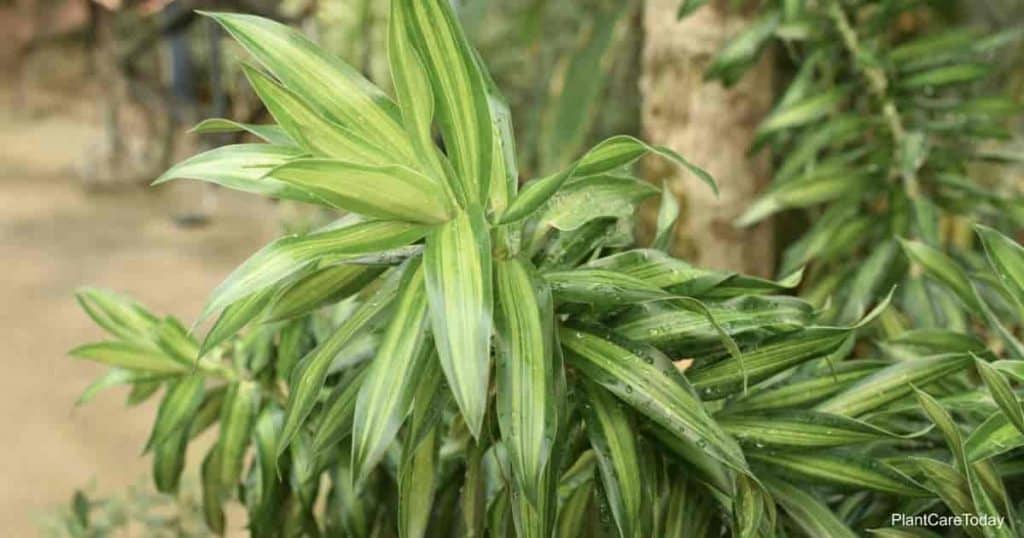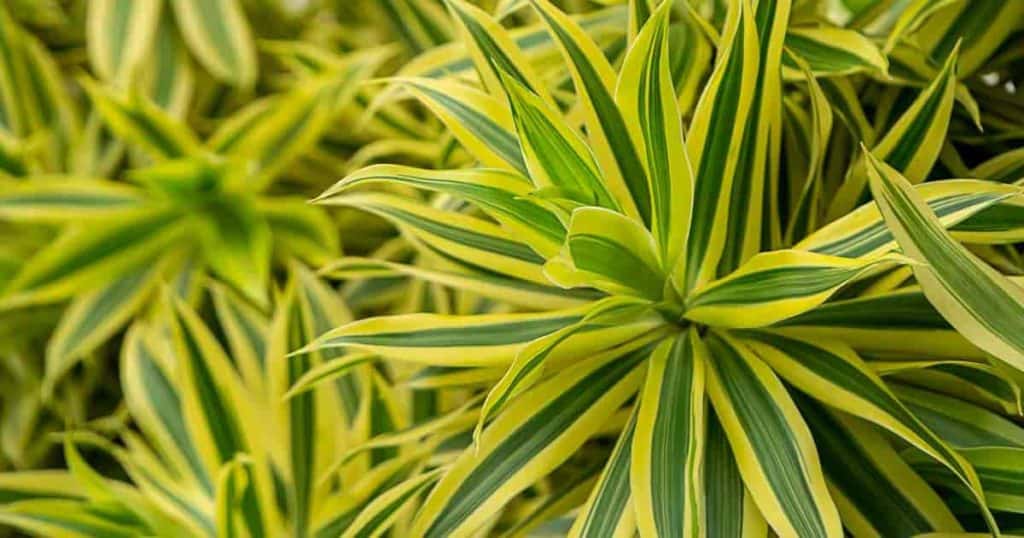With bright chartreuse foliage and interesting growth habit, makes Dracaena reflexa [dra-SEE-nah, ree-FLEKS-uh] a popular houseplant.
The visually striking foliage of this type of Dracaena which belongs to the Asparagaceae family, is an eye catcher.

There are several varieties of the Dracaena reflexa plant sold as house plants on the market including:
- Dracaena reflexa – green leaves
- Dracaena reflexa Song of India
- Dracaena reflexa Song of Jamaica
This is because it is native to various islands in the Indian Ocean such as Madagascar, Mauritius, and Mozambique.
It was first described in 1786 by Jean-Baptist Lamarck and has now become a popular ornamental houseplant.
Some of the more popular Dracaena varieties include:
- Red Edged Dracaena – Dracaena Marginata (Madagascar dragon tree)
- Janet Craig Dracaena
- Janet Craig compacta
- Dracaena Warneckii
- Dracaena fragrans
- Mass Cane Plant – Dracaena fragrans ‘Massengaena’ (Corn Plant)
Dracaena reflexa Care
Size & Growth
The main attraction of the Song of India plant is its dark green leaves growing in tight whorls. The color of these leaves is what makes the plant special.
They are glossy and can grow up to 1’ foot long and a couple of inches wide.
Typically, Dracaena reflexa plants reaches a height of 13’ – 16’ feet tall. Rarely, the plant can grow up to 19’ feet tall.
They gradually lose the bottom leaves as the plant grows taller. However, the plant is much shorter when grown as indoor plants.

Flowering and Fragrance
Dracaena song of Jamica plants do produce flowers. They are usually very small and clustered.
The flowers might not be as noticeable as they are usually nearly white and very strongly fragrant.
Light & Temperature
Dracaena pleomele plants are hardy to USDA hardiness zones 10 – 11.
They do well in normal room temperatures, which are around 65° – 75° degrees Fahrenheit (18° C – 24° C).
Comparatively, reflexa plants are more tolerant to hot than cold.
Temperature below 50° degrees Fahrenheit (10° C) is harmful.
Also, when placing it as an indoor plant, make sure you keep them away from cold drafts.

Pleomele plants also love high humidity and consistent year-round temperatures, dry environments cause its tips to turn brown.
For lighting, bright indirect light is best suited for reflexas’ growth.
Bright light will bring out great colors on the leaves.
However, keep the plant out of the direct sun as it can cause right scorches on the leaves.
It can survive in relatively low light levels but aim for high light for its typical living setting.
Watering and Feeding
Song of India Dracaena doesn’t have water-storing capabilities and prefer to be kept on the dry side.
Hence, they are a little demanding when it comes to watering them and over-watering should be avoided to prevent root rot.
Fortunately, it doesn’t require a lot of maintenance, which makes it easy to care for.
During spring and most of the fall, keep the potting soil slightly moist at all times.

Water them regularly; making sure 50% of the soil dries out before you do.
In winter, keep the soil dry.
Typically, you should be able to leave your reflexa plant for 10 -14 days without water.
Use a diluted liquid fertilizer and feed the plants every 6-8 weeks from April until September. Too much fertilizer will cause brown leaf tips.
Soil & Transplanting
All dracaena species, including D. reflexa, respond well to loose, well-draining soil.
This prevents water from accumulating and standing around roots for long periods of time, preventing root rot.
Use an all-purpose houseplant potting mix for your Dracaena plants.
If it doesn’t drain well, add sand to the mixture to improve it.

When growing the Dracaenas in pots, transplanting is advised when the root system fills the container.
Gently lift the plant, attesting the roots have reached the bottom.
Then repot them in bigger pot sizes or in the ground.
When transplanting a potted Song of India Dracaena plant, make sure you do so about every 2 years to promote better growth.
Grooming and Maintenance
As the plant continues to grow, you’ll find the lower leaves will turn yellow. This is normal and easy to deal with.
Remove them when they start to turn yellow.
Pruning is often overlooked which leads to an intrusive overgrown plant.
Since the plant reacts well to pruning, prune back any extra growth.
Doing so will also promote the plant to sprout multiple new heads, creating a bushier plant.
How To Propagate Dracaena Plants

Pleomele plants propagate easily from stem cuttings.
- In spring, take 3” – 5” inch long stem tip cuttings
- Dip the base of the cutting int a plant rooting powder and place them into a new pot.
- Place two or three cuttings together for a fuller effect.
- Use a moist sterile potting mix as cuttings root quite easily.
- Keep the new plants in a shaded area while they develop roots.
- Once the plant become established move the young plants to brighter light.
Reflexa Pest or Disease Problems
One of the most common houseplant pests affecting Dracaena reflexa is Mealybugs. To control the infestation, remove the affected parts, and move the plant outside.
More on: Controlling Mealybugs on Dracaena
If the plant environment is too warm and dry it will attract spider mites.

Spray the entire plants to remove the mealies and then use an insecticide soap or common dish soap to get rid of the remaining bugs.
Dracaena plants are often affected by fusarium leaf spot disease.
These spots typically form on young leaves or leaf tips staying wet for too long.
Over time, they turn brown and often have a yellow margin.
Suggested Uses For Dracaena Pleomele
Reflexa is mainly used as an ornamental plant grown indoors as a house plant and outdoors for landscaping.
It’s frequently used as a specimen floor plant, as an accent plant, or pruned to create garden hedge.

The leaves and bark of the plant are also mixed with other native plants to make herbal teas.
NASA used Dracaena plants in their Clean Air Study program, showing its capability to remove formaldehyde.
